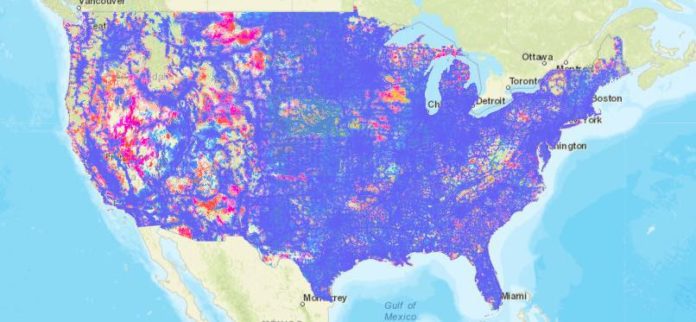The Federal Communications Commission has released a new map of mobile network coverage for voice and data from AT&T, Verizon, T-Mobile US and US Cellular, in another step toward improving the accuracy of its mapping data.
The agency said that this is the first public map it has released showing updated mobile coverage and “represents a
significant improvement over other data previously published by the agency. It also serves as a public test of the standardized criteria developed to facilitate improved mapping under the Broadband DATA Act.”
The map can be accessed here. It can be configured to show coverage layers for LTE voice and LTE data from the four largest facilities-based network providers in the United States.
An information pop-up for the map says that the information is as of May 15, 2021 from Form 477 data. However, the map itself gives more detailed statistics on which it is based: For voice, a 90% cell edge probability and 50% cell loading factor, at a maximum resolution of 100 meters. For data, the map is supposed to show a minimum of 5/1 Mbps speed with a 90% cell edge probability, 50% cell loading factor and maximum resolution of 100 meters. The FCC said that the map gives a “preview of how the mobile data the FCC will collect under the standards set
by the Broadband DATA Act will look when mapped.Never before have maps been created using these new, standardized mobile data specifications, which will improve the uniformity and consistency of broadband availability data collected by the FCC.”
Acting FCC Chairwoman Jessica Rosenworcel said that the new map represents progress in the FCC’s efforts to improve the accuracy of its maps and understanding of where both wired broadband and mobile network coverage are available — and unavailable — in order to make more targeted funding awards based on good information.
“A good map is one that changes over time. Today’s new map represents progress in our efforts to implement the Broadband DATA Act and build next-generation broadband maps that can help to connect 100 percent of Americans,” said Rosenworcel. “Using improved systems and data we can provide better information about where broadband service is and is not across the country. While much work remains, I congratulate the Broadband Data Task Force for moving full speed ahead on this essential mission.”
Rosenworcel’s tweet about the new map was immediately met by responses from consumers reporting inaccuracies.
CCA President and CEO Steve Berry said in a statement that the new map is “a helpful first step towards generating more reliable coverage maps.
“We look forward to reviewing the maps to assess whether they improve the reliability of the coverage predictions. I agree with Acting Chairwoman Rosenworcel that ‘next-generation broadband maps … can help to connect 100 percent of Americans,'” Berry added. “With focus now on 5G deployment, we look forward to working with the FCC and Congress to make the Broadband Data Collection a success and ensure that reliable data drives decisions to support nationwide coverage with the latest mobile services.”
The FCC said that it is continuing with additional efforts to improve wireline and wireless data and mapping. Last month, it chose a vendor for critical systems development and it said that procurement is also underway for its new Broadband Serviceable Locations Fabric; meanwhile, it is also taking comment on technical details around challenges to and verification of mobile maps (which was a major stumbling block for a recent funding award program). The Broadband Data Task Force is holding a webinar on Thursday, August 12 discussing comments and proposals for mobile maps.

